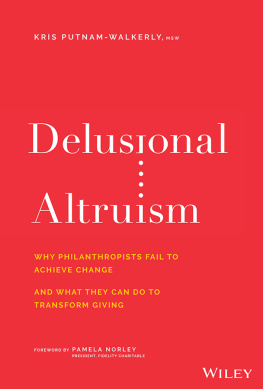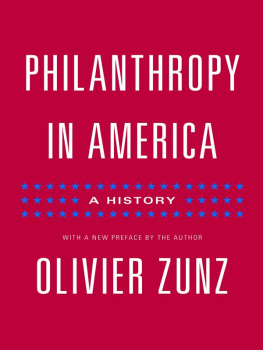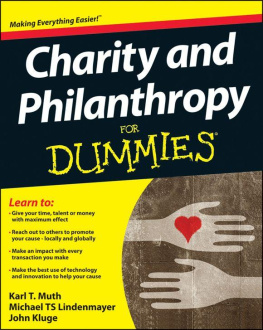Copyright 2019 by Phil Buchanan
Foreword copyright 2019 by Darren Walker
Cover design by Pete Garceau
Cover image iStock/Getty Images
Cover copyright 2019 Hachette Book Group, Inc.
Hachette Book Group supports the right to free expression and the value of copyright. The purpose of copyright is to encourage writers and artists to produce the creative works that enrich our culture.
The scanning, uploading, and distribution of this book without permission is a theft of the authors intellectual property. If you would like permission to use material from the book (other than for review purposes), please contact permissions@hbgusa.com. Thank you for your support of the authors rights.
PublicAffairs
Hachette Book Group
1290 Avenue of the Americas, New York, NY 10104
www.publicaffairsbooks.com
@Public_Affairs
First Edition: April 2019
Published by PublicAffairs, an imprint of Perseus Books, LLC, a subsidiary of Hachette Book Group, Inc. The PublicAffairs name and logo is a trademark of the Hachette Book Group.
The Hachette Speakers Bureau provides a wide range of authors for speaking events. To find out more, go to www.hachettespeakersbureau.com or call (866) 376-6591.
The publisher is not responsible for websites (or their content) that are not owned by the publisher.
Library of Congress Cataloging-in-Publication Data has been applied for.
ISBNs: 978-1-5417-4225-3 (hardcover); 978-1-5417-4223-9 (ebook)
E3-20190311-JV-NF-ORI
Phil Buchanan has dedicated his professional life to the question of what makes philanthropy most effective. Throughout, he has remained committed to the idea that nonprofits need a disciplined focus on results, while also keeping clear that nonprofits differ in significant ways from business. Anyone who seeks to achieve impactful philanthropy would do well to learn from his vast experience and deep wisdom.
Jim Collins, author of Good to Great, coauthor of Built to Last
Phil Buchanan is arguably the best informed and most insightful thought leader in philanthropy today, and this book shows him at his best: Like its author, Giving Done Right is grounded in data, animated by real stories well told, and provocative in ways that shed more light than heat. An essential and highly readable guide for foundations and donors ready to move beyond feeling good to doing good.
Richard Ober, president and CEO, New Hampshire Charitable Foundation
Giving Done Right punctures myths and provides helpful guidance about the complexities and joys of philanthropy. Buchanan makes a persuasive and always practical case for why nonprofits are not like businesses, why giving is not like investing, and how readers can find their own satisfying path to doing great good.
Rosabeth Moss Kanter, Arbuckle Professor, Harvard Business School, founder of the Harvard University Advanced Leadership Initiative
Giving is easy. Giving with real impact is anything but. In this go-to primer, Phil Buchanan offers invaluable insights about the art and practice of strategic philanthropy.
Stephen Heintz, president, Rockefeller Brothers Fund
Giving Done Right should be required reading for anyone looking to better understand how to achieve more effectiveness in their giving. Phil Buchanans research, data, and storytelling make clear the challenges with bringing a business mindset to solving social problems. This book provides a thorough overview of the change in mindset necessary to attain more satisfaction with your giving.
Pamela Norley, president, Fidelity Charitable
The Center for Effective Philanthropy created the first-ever genuine accountability mechanism for determining the effectiveness of foundation performance. Phil Buchanan first articulated the obvious need, crafted a workable mechanism for measuring performance, and then succeeded in selling it to foundation officers and trustees. That Grantee Perception Report has now become the gold standard for foundations to assess the effectiveness of their giving on all important criteria. In Giving Done Right, Buchanan has widened his clear vision beyond foundations by providing a reliable guide for all donorsindividuals, foundations, corporations, and indeed recipients of charitable dollarswho are determined to do their charitable giving and spending the right way. Anyone resolved to get the biggest and wisest bang for their charitable dollars need look no further for guidance now than this experience-filled, reader-friendly book.
Joel Fleishman, director of the Duke University Center for Strategic Philanthropy, author of Putting Wealth to Work: Philanthropy for Today or Investing for Tomorrow?
Phil Buchanan knows and celebrates the diversity of the nonprofit sector, from the smallest community-based organization to the largest university or museum; from the individual donor making small annual gifts to her favorite charities to the largest private foundation awarding hundreds of millions in grants. Giving Done Right is full of data, insights, and helpful suggestions for us all.
Carol Larson, president and CEO, David and Lucile Packard Foundation
For Lara
This book would not exist were it not for the support of the Board of Directors and staff of the Center for Effective Philanthropy (CEP), the nonprofit organization where I have worked for the past seventeen years. Although the views expressed in these pages are mine, I have drawn heavily on research and knowledge developed by CEP. I am grateful for all the support I have received in undertaking this project. Fifty percent of all royalties associated with the sale of this book for the first year following its publication will go to CEP to support its ongoing work.
We live in a time of many urgent challenges. Inequality has widened the gap between the rich and the poor. In the United States, the free press is under attack, while mass incarceration tears at the fabric of our society. Racism and nationalism are on the rise around the world, while people find their opportunities inhibited by persistent injustices based on their gender, race, sexual orientation, ability, or citizenship status. Meanwhile, climate change threatens the planet and people everywhere. The list goes on.
These challenges seem daunting on their own. They might even appear insurmountable when we consider the finite resources we have to solve them. Yet what gives me hope is that people from every walk of life see those problemsin their local communities, nations, and worldand ask, How can I help?
For many people and through many decades, one answer to that question has been philanthropy. In fact, when Andrew Carnegie wrote his 1889 essay Wealth, he envisioned philanthropy as a necessary and effective means of ameliorating the worst conditions the free market produced. The idea that the wealthy were obligated to give away money during their lifetime was radical at the time. Following the publication of Carnegies essay, what we now know as the modern field of philanthropy emerged. As a result, millions of people have access to tools and resources with which to improve their lives.
In the 130 years since Carnegies original essaynow known as the Gospel of Wealththe number of people, foundations, and resources joining the field of philanthropy only continues to grow. At the same time, we have continued to learn, and we know more today than Carnegie could have imagined. We have gained experiences, understanding, and perspective from decades of success and failure. We have new technologies, data, research, and tools available to help us. We have learned more about how to be effectivehow to understand the root causes of problems, build institutions, and partner with communities to ensure they have a voice in the decisions that affect them. We have new insights into how structural inequalities, unconscious biases, and systemic injustices have influenced what weve done wrong in the past and where we are today.





